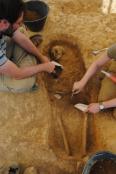CAMPAGNA 2017 |
1° SETTIMANA |
2° SETTIMANA |
3° SETTIMANA |
4° SETTIMANA |
5° SETTIMANA |
6° SETTIMANA |
7° SETTIMANA |
8° SETTIMANA |
19 LUGLIO 2017 
Resoconto della giornata di scavo
Area 2000
The day began with the removing of the pelvis from Skeleton #2813. Taylor and Analisa than proceeded to close out Cut #2815 and clean up the Eastern side of area 2000 with trowels. Meanwhile the other excavators continued to level out the western half of Area 2000 with pickaxes and shovels.
Approximately halfway through the day, Jordi and Ryan joined the geologists on a journey to acquire core soil samples. Since we had so much pick-axing to do still, Tommaso was transferred into Area 2000. For the rest of the day, the entire crew worked together to lower the western side to the desired depth. Along the way we uncovered a few potential burials, but just took note of their locations instead of starting excavations. At the end of the day we did a final cleaning with trowels across the entire area.
Area 3000
Nella porzione nord-occidentale del settore si è proceduto con la documentazione e la successiva rimozione dell’individuo mal preservato USK 3829, orientato W-E e deposto supino in US – 3805. Più ad est è iniziata l’indagine della tomba US – 3813, orientata S-N, contenente i resti scheletrici di un individuo adulto apparentemente in buono stato di conservazione.
Today, July 19th 2017 in area 3000 we continued revealing the skeleton USK 3828, covered by fill number 3814, in the northeast corner of section b. We have thus far revealed the femurs, a small section of the pelvis, and most of the skull, as well as a single hand phalanx and left patella. Based on the back-tilted orientation of the skull, position of the finger and kneecap, distance between the coxal bones, and disconnection between the cranium and mandible, which has not yet been found, it was most likely an empty space burial. We also found a partial tibia in the fill above the pelvis, most likely scatter from the trench that bisects the skeleton's femurs. We also continued cleaning skeleton USK 3800 on the western side of section B, and skeleton USK 3829 in the northwest corner of section b, of which all of the lower limbs except for the right foot have been removed. An additional cranium has been discovered under the left foot of skeleton 3829, indicative of another burial or possible bone scatter cut by the grave containing 3829. Tomorrow we will continue to clean 3828 and 3800 and complete removal of 3829.
Area 5000
Continua lo scavo del settore D in cui si sta rimuovendo uno strato (US 5425) composto da una matrice argillosa in cui sono presenti numerosi frammenti litici e ceramici. Questo sembra essere molto simile a livelli già individuati nei precedenti anni di scavo. Questo strato costituisce infatti una superficie utilizzata come piano stradale o pavimentale in età moderna che si estendeva su tutta la porzione orientale dell'area 5000. Nella zona orientale del settore B invece è stata individuata una struttura muraria orientata in senso E-O che sembra perpendicolare alla struttura muraria che costituisce il muro esterno del chiostro. Sono però necessarie ulteriori indagini per potersi accertare del rapporto tra le varie strutture già presenti nell'area di scavo.
Area 6000
Today, area 6196 continued uncovering the skeleton previously discovered yesterday. The cranium was completely uncovered in preparation for excavation. Those excavating burial 6199 continued to excavate and expose the bones of the skeleton, although many of the bones did not preserve very well. Both radaii and ulnae are exposed. There is a plant root that has a negative effect across the right side of the pelvis and that travels across where the vertebrae are to be and resubmerges in the soil under the left radius and ulna. In area 6201, which was mislabeled in yesterday's entry as 6193, we extended the area of exposure to the shoulder of the specimen. We were able to expose both humeri as well as the right acromion and fully exposed the ulnae and radii. The fill was composed of a light brown/yellow soil and small stones. The surrounding soil was yellow with flecks of red, as well as bits of white and yellow clay.















